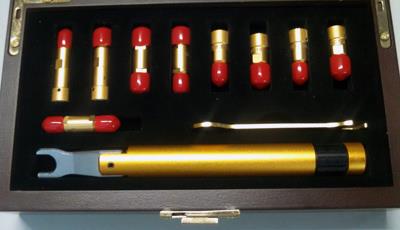
|
|
The Custom-Cal CC50-3.5-26 is a 50 Ohm, DC to 26.5 GHz, 3.5 mm-type Standard Calibration Kit. It consists of a; CC-5002-OF Open Female Connector, CC-5002-OM Open Male Connector, CC-5002-SF Short Female Connector, CC-5002-SM Short Male Connector, CC-5002-LF Load Female Connector, CC-5002-LM Load Male Connector, CC-5002-TF Through Female to Female Connector, CC-5002-TFM Through Female to Male Connector, CC-5002-TM Through Male to Male Connector, 7mm flat wrench and a 8710-1765CC 8 in-lbs [0.9 N.m] Break-Over Torque Wrench..
Specifications.
Open Female Connector.
Frequency Range: DC to 26.5 GHz.
Impedance: 50 Ω.
Phase (DC to 3 GHz): 0.65 degree.
Phase (3 to 8 GHz): 1.2 degree.
Phase (8 to 26.5 GHz): 2 degree.
Open Male Connector.
Frequency Range: DC to 26.5 GHz.
Impedance: 50 Ω.
Phase (DC to 3 GHz): 0.65 degree.
Phase (3 to 8 GHz): 1.2 degree.
Phase (8 to 26.5 GHz): 2 degree.
Short Female Connector.
Frequency Range: DC to 26.5 GHz.
Impedance: 50 Ω.
Phase (DC to 3 GHz): 0.65 degree.
Phase (3 to 8 GHz): 1.2 degree.
Phase (8 to 26.5 GHz): 2 degree.
Short Male Connector.
Frequency Range: DC to 26.5 GHz.
Impedance: 50 Ω.
Phase (DC to 3 GHz): 0.65 degree.
Phase (3 to 8 GHz): 1.2 degree.
Phase (8 to 26.5 GHz): 2 degree.
Load Female Connector.
Frequency Range: DC to 26.5 GHz.
Impedance: 50 Ω.
Return Loss (DC to 3 GHz): 44 dB minimum.
Return Loss (3 to 6 GHz): 36 dB minimum.
Return Loss (6 to 26.5 GHz): 30 dB minimum.
Load Male Connector.
Frequency Range: DC to 26.5 GHz.
Impedance: 50 Ω.
Return Loss (DC to 3 GHz): 44 dB minimum.
Return Loss (3 to 6 GHz): 36 dB minimum.
Return Loss (6 to 26.5 GHz): 30 dB minimum.
Through Female to Female Connector.
Frequency Range: DC to 26.5 GHz.
Impedance: 50 Ω.
Insertion Loss (DC to 26.5 GHz): 0.2 dB maximum.
Return Loss (DC to 8 GHz): 30 dB minimum.
Return Loss (8 to 18 GHz): 28 dB minimum.
Return Loss (18 to 26.5 GHz): 26 dB minimum.
Through Female to Male Connector.
Frequency Range: DC to 26.5 GHz.
Impedance: 50 Ω.
Insertion Loss (DC to 26.5 GHz): 0.2 dB maximum.
Return Loss (DC to 8 GHz): 30 dB minimum.
Return Loss (8 to 18 GHz): 28 dB minimum.
Return Loss (18 to 26.5 GHz): 26 dB minimum.
Through Male to Male Connector.
Frequency Range: DC to 26.5 GHz.
Impedance: 50 Ω.
Insertion Loss (DC to 26.5 GHz): 0.2 dB maximum.
Return Loss (DC to 8 GHz): 30 dB minimum.
Return Loss (8 to 18 GHz): 28 dB minimum.
Return Loss (18 to 26.5 GHz): 26 dB minimum.
|